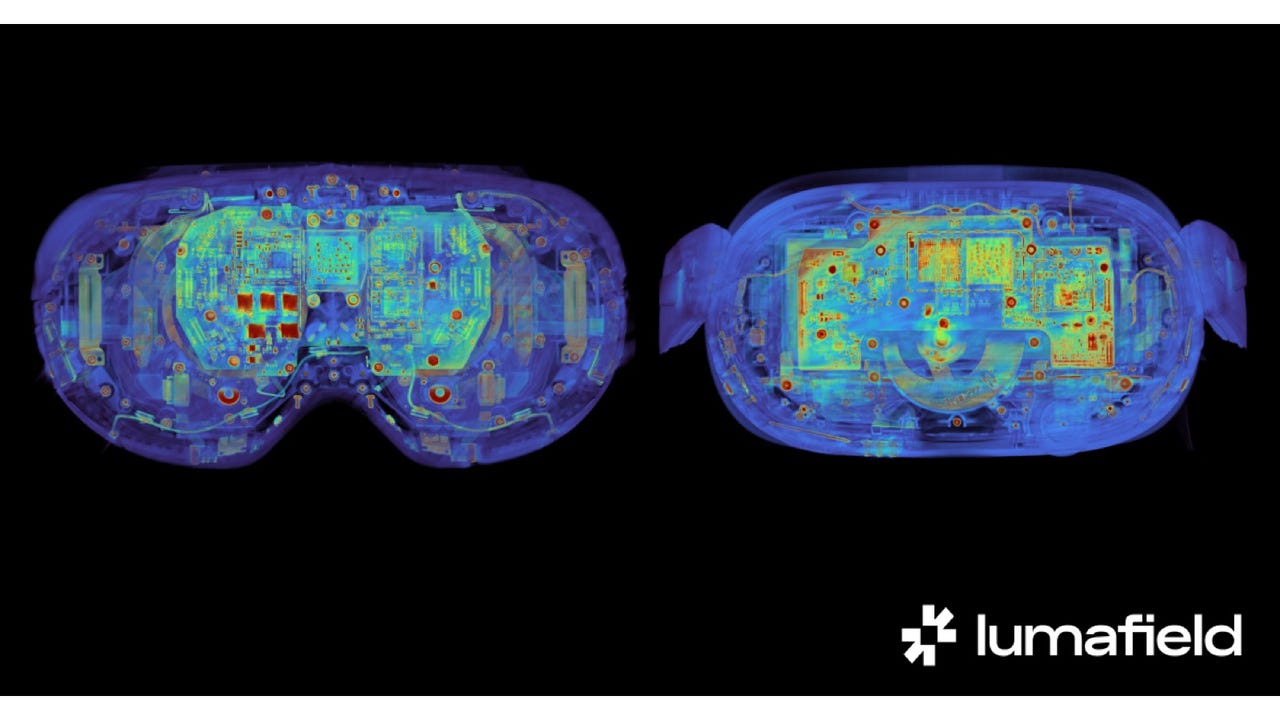
































CT scans of the Meta Quest Pro (left) and Meta Quest 3 (right).
We've all seen those teardowns where the Apple Vision Pro and Meta's Quest 3 and Quest Pro headsets are dismantled down to their component bits and pieces. While this approach gives us a peek at what's inside, it's tough to understand how everything fits. Plus, many new products don't exactly come out of these teardowns unscathed.
To truly understand how all the parts work together, we need a method to peek inside the devices without causing any damage.
Also: Apple Vision Pro FAQ: Price, features, hands-on insights
Enter Lumafield, a Massachusetts company specializing in AI-assisted CT scanning that uses the power of industrial X-ray scanners to see what's really going on inside tech products -- without taking anything apart.
This time, the two most popular augmented and virtual reality headsets got the non-destructive teardown treatment. Lumafield dove into the differences between Apple's$3,500 Vision Pro headset and Meta's$500 Quest 3 headset -- all without a single screw being undone or a delicate screen being cracked.
The scans reveal how much tech is crammed into these devices, and it all begins with the design. A headset needs to look, well, like a headset, which means everything must be meticulously arranged to fit within that distinctive shape.
The respective approaches taken by Apple and Meta to pack everything into their headsets are quite striking in their differences. For instance, Apple's engineers concluded that using an external battery was the most straightforward solution, whereas Meta's team landed on a unique curved battery.
Also: I've tried Vision Pro and other top XR headsets and here's the one most people should buy
Squeezing so much technology into a device meant to sit right in front of your face introduces some tricky thermal challenges. These CT scans also offer a glimpse into the innovative cooling technologies used to keep things comfortable.
Meta chose a more traditional path with fans and copper heat pipes for cooling, while Apple opted for micro fans to keep the Vision Pro's internals cool. Despite their differences, both strategies aim to ensure the headsets don't roast the wearer's face.
Apple Vision Pro micro-blower (left), Meta Quest Pro heat pipe and fans (right).
So, which is the better headset? This is where these non-destructive teardowns come into their own. If you look at the device simply from the perspective of its components, then Apple's Vision Pro looks like the winner. As Lumafield says in its blog though: "Meta's two headsets demonstrate a striking economy of means," and, "the frugal construction and best-in-class value of the devices is as impressive a feat as Apple's elegant vision statement."
Also: The Apple products you shouldn't buy this month
This elegance becomes clearer when you view the headset as a whole, especially when you peer through its outer shell and see the inner workings that make it tick. The technology gives us an X-ray view into the beating heart of the technology.
Want to see more? Lumafield has detailed 3D reconstructions of the headsets on its website that you can explore.
 Tags chauds:
technologie
Tags chauds:
technologie